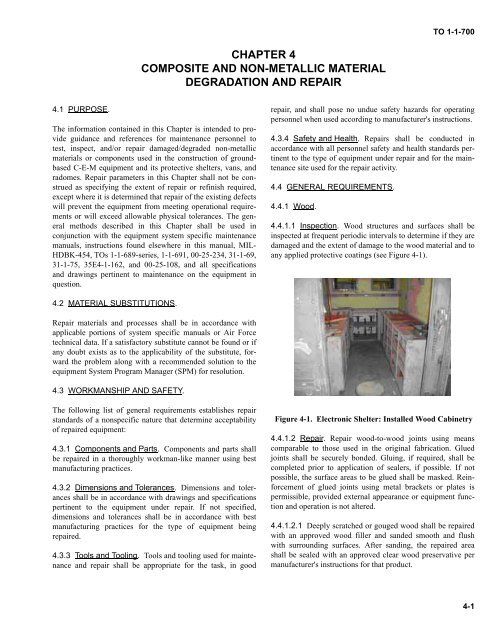TO 1-1-700 - Robins Air Force Base
TO 1-1-700 - Robins Air Force Base
TO 1-1-700 - Robins Air Force Base
Create successful ePaper yourself
Turn your PDF publications into a flip-book with our unique Google optimized e-Paper software.
<strong>TO</strong> 1-1-<strong>700</strong><br />
CHAPTER 4<br />
COMPOSITE AND NON-METALLIC MATERIAL<br />
DEGRADATION AND REPAIR<br />
4.1 PURPOSE.<br />
The information contained in this Chapter is intended to provide<br />
guidance and references for maintenance personnel to<br />
test, inspect, and/or repair damaged/degraded non-metallic<br />
materials or components used in the construction of groundbased<br />
C-E-M equipment and its protective shelters, vans, and<br />
radomes. Repair parameters in this Chapter shall not be construed<br />
as specifying the extent of repair or refinish required,<br />
except where it is determined that repair of the existing defects<br />
will prevent the equipment from meeting operational requirements<br />
or will exceed allowable physical tolerances. The general<br />
methods described in this Chapter shall be used in<br />
conjunction with the equipment system specific maintenance<br />
manuals, instructions found elsewhere in this manual, MIL-<br />
HDBK-454, <strong>TO</strong>s 1-1-689-series, 1-1-691, 00-25-234, 31-1-69,<br />
31-1-75, 35E4-1-162, and 00-25-108, and all specifications<br />
and drawings pertinent to maintenance on the equipment in<br />
question.<br />
repair, and shall pose no undue safety hazards for operating<br />
personnel when used according to manufacturer's instructions.<br />
4.3.4 Safety and Health. Repairs shall be conducted in<br />
accordance with all personnel safety and health standards pertinent<br />
to the type of equipment under repair and for the maintenance<br />
site used for the repair activity.<br />
4.4 GENERAL REQUIREMENTS.<br />
4.4.1 Wood.<br />
4.4.1.1 Inspection. Wood structures and surfaces shall be<br />
inspected at frequent periodic intervals to determine if they are<br />
damaged and the extent of damage to the wood material and to<br />
any applied protective coatings (see Figure 4-1).<br />
4.2 MATERIAL SUBSTITUTIONS.<br />
Repair materials and processes shall be in accordance with<br />
applicable portions of system specific manuals or <strong>Air</strong> <strong>Force</strong><br />
technical data. If a satisfactory substitute cannot be found or if<br />
any doubt exists as to the applicability of the substitute, forward<br />
the problem along with a recommended solution to the<br />
equipment System Program Manager (SPM) for resolution.<br />
4.3 WORKMANSHIP AND SAFETY.<br />
The following list of general requirements establishes repair<br />
standards of a nonspecific nature that determine acceptability<br />
of repaired equipment:<br />
4.3.1 Components and Parts. Components and parts shall<br />
be repaired in a thoroughly workman-like manner using best<br />
manufacturing practices.<br />
4.3.2 Dimensions and Tolerances. Dimensions and tolerances<br />
shall be in accordance with drawings and specifications<br />
pertinent to the equipment under repair. If not specified,<br />
dimensions and tolerances shall be in accordance with best<br />
manufacturing practices for the type of equipment being<br />
repaired.<br />
4.3.3 Tools and Tooling. Tools and tooling used for maintenance<br />
and repair shall be appropriate for the task, in good<br />
Figure 4-1. Electronic Shelter: Installed Wood Cabinetry<br />
4.4.1.2 Repair. Repair wood-to-wood joints using means<br />
comparable to those used in the original fabrication. Glued<br />
joints shall be securely bonded. Gluing, if required, shall be<br />
completed prior to application of sealers, if possible. If not<br />
possible, the surface areas to be glued shall be masked. Reinforcement<br />
of glued joints using metal brackets or plates is<br />
permissible, provided external appearance or equipment function<br />
and operation is not altered.<br />
4.4.1.2.1 Deeply scratched or gouged wood shall be repaired<br />
with an approved wood filler and sanded smooth and flush<br />
with surrounding surfaces. After sanding, the repaired area<br />
shall be sealed with an approved clear wood preservative per<br />
manufacturer's instructions for that product.<br />
4-1
















